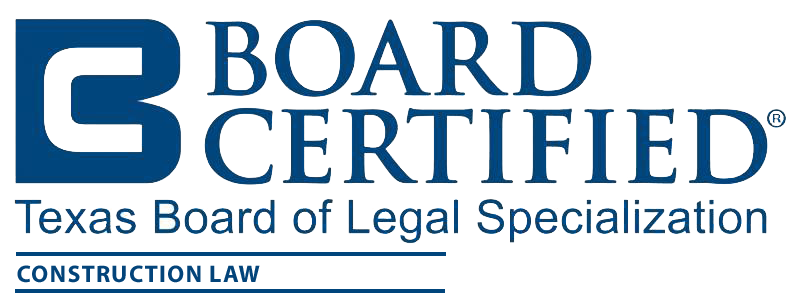The Texas Board of Legal Specialization has certified approximately 135 Texas lawyers as Board Certified in Construction Law. Lovein Ribman’s construction law department is overseen by two of those Board Certified lawyers. We represent homeowners across the entire state of Texas with resolving disputes with their builders/contractors for design defects, construction defects, delay claims, breach of warranty claims, project abandonment, non-payment of subcontractors, release of invalid/fraudulent mechanic’s liens, and all other issues that commonly arise during and after the construction of a new home or remodel project. As Board Certified Construction Attorneys, we have first-hand experience with every type of residential construction dispute imaginable. We understand the problems homeowners encounter with new home and remodel construction projects, and know how to efficiently and effectively resolve them. If you are in a dispute with your builder/contractor, or anticipate one, please call us at (888) 368-2483. We offer consultations ranging from 15 minutes to 1 hour, wherein we can review and discuss the applicable provisions of your Contract, explain your rights and your Contractor/Builder’s obligations, analyze your claim, answer any related questions and recommend a course of action. To learn more about the 10 most common residential construction disputes and how to initiate a claim against your new home builder or home remodel contractor, read on below.
Ten Most Common Residential Construction Disputes
The ten most common residential new and remodel construction disputes are: (1) design defects; (2) defective workmanship; (3) unreasonable delays in completing the work; (4) failure to provide project accounting and maintain a construction account; (5) failure to submit and execute change orders; (6) failure to honor an express or implied warranty; (7) project abandonment after receiving payment for work not performed; (8) contractor’s failure to pay subcontractors; (9) invalid/fraudulent lien filed by the contractor or its subcontractor/suppliers; and (10) failure to understand a stipulated sum or lump sum contract. To learn more about these common residential construction disputes and how to resolve them, please read below.
- Design Defects
- Defective Workmanship
- Unreasonable Delays
- Failure to Provide Project Accounting and Maintain a Construction Account
- Failure to Submit Change Orders
- Failure to Honor an Express Warranty
- Project Abandonment
- Contractor’s Failure to Pay Subcontractors
- Removal of Invalid Mechanic’s Lien
- The Stipulated Sum or Lump Sum Contract
1. Design Defects
Design defects can arise from deficiencies in the architectural plans, civil plans, and/or structural plans and are most common with new custom home builds, but also occur with tract homes or remodel projects. In some instances the homeowner directly retains the design professional and would therefore have a direct claim against the architect or engineer. With turn-key projects or tract homes, the builder typically retains the design professional allowing the homeowner to bring the claim directly against the builder. Architects and engineers are held to a high standard of care and are responsible for their design defects. Sometimes the defects are discovered during the progress of the work and other times several years after the work has been completed. In either case, the first steps to initiating a claim for defective design are typically: (1) review of your contract for your rights and obligations; (2) retain a third-party architect or engineer to review the plans to determine the nature of the defects; and (3) obtain an estimate from a contractor to correct the defective work. In order to assert a claim against an architect or engineer for breach of professional services, you must first retain a third-party professional who holds the same or similar license to opine under oath that the architect or engineer’s design fell below the standard of care. This is known as a Certificate of Merit and is only required when bringing a claim against an architect, engineer, or a design-build contractor. A claim against an architect, engineer, or design-build contractor must be brought within the applicable statute of limitations. In Texas, most claims for design defects have a 2 – 4 year statute of limitations that begins to accrue when the property owner discovered or could have reasonably discovered the defect.
2. Defective Workmanship
Contractors are expected to perform their work in a good workmanlike manner and failure to do so constitutes a breach of contract. The first steps to initiate a claim for defective work are typically: (1) review of your contract for your rights, obligations, and notice requirements; (2) retain an independent contractor to inspect the defective work and to determine the nature of the defect; and (3) obtain an estimate from an independent contractor to correct the defective work. A claim against a builder/contractor must be brought within the applicable statute of limitations. In Texas, most claims for construction defects have a 2 – 4 year statute of limitations that begins to accrue when the property owner discovered or could have reasonably discovered the defect. A claim for defective work starts by serving the builder/contractor with a Texas Property Code Chapter 27 and Deceptive Trade Practice Act Demand. See below for how to initiate a claim against your builder/contractor for construction defects under Texas Property Code, Chapter 27.
3. Unreasonable Delays
Delays are common in construction and can be very frustrating and disruptive for the homeowner. While some delays are excusable, e.g., bad weather, changes in the work, and material shortages, most are not and can provide the homeowner with a basis to terminate the builder/contractor and seek damages caused by the delay. The first step in analyzing a delay claim is to review your contract (if you have one) for: (1) the agreed upon completion date; (2) a “time is of the essence” provision, which is a legal term that requires strict adherence to contractual deadlines; (3) the default provision, which should identify what constitutes a default; (4) the notice provision, which will tell you how to notify the builder/contractor of a default; and (5) determination of whether the contract contains a “Consequential Damage Waiver”, wherein both parties waive their respective right to recover consequential damages suffered as a result of a delay.
Contractor Delays can occur from: (1) failure to timely mobilize; (2) failure to manage the project; (3) failure to coordinate subcontractors; (4) failure to purchase and deliver materials; (5) failure to provide adequate manpower; (6) failure to adhere to the project schedule; (7) failure to properly perform the work resulting in correction work; and (8) failure to timely obtain permits.
Property Owner Delay Damages typically include, if not waived by the Contract: (1) increased cost of construction; (2) increased rental and storage fees; and (3) increased interest and financing fees. Sometimes a property owner’s delay damages are quantified in the contract as liquidated damages. However, to be enforceable, a liquidated damage provision must pass a two-part test: (1) the damages must be incapable or difficult to estimate at the time of entering into the contract; and (2) the liquidated damage amount is a reasonable forecast of the actual damage that would be suffered from the delay.
4. Failure to Provide Project Accounting and Maintain a Construction Account
Most contractors do not like to share the project accounting with the homeowner because it exposes their true profit margin. However, in some instances they are required to do so. The most common situation wherein a builder/contractor is required to provide project accounting, is on a Cost Plus a Fee Contract, meaning the homeowner is paying for the “cost of the work” and a flat builder fee. Under this type of contract, the builder/contractor is required to maintain all project costs and provide updated accounting for all expenses. Under a Lump Sum or Stipulated Sum Contract, the builder/contractor may not be required to provide the entire project accounting since the builder/contractor is obligated to build the home or complete the remodel for a set price and assumes the risk of cost overruns. However, if a Lump Sum or Stipulated Sun Contract contains allowances or extras, then the builder/contractor is required to provide an accounting for these line items. Additionally, if the homeowner has received a “pre-lien notice” or “intent to lien” from one or more of the builder/contractor’s subcontractors/suppliers, then it would be appropriate to demand an accounting of these line items as well. See the section below entitled “Failure to Pay Subcontractors” for a discussion on how to respond to a builder/contractor’s failure to pay its subcontractors/suppliers.
Further, on homestead projects where the contract amount is over $5,000.00, the contractor is required to maintain a “construction account” for the benefit of the homeowner. Failure to maintain a construction account is a misdemeanor. If the contractor has maintained a construction account, a demand should be made for proof of the account and all project invoices paid from the account.
5. Failure to Submit Change Orders
So many disputes arise over change orders, or the lack thereof. Change order provisions are one of the most litigated aspects of residential construction contracts. Most contracts contain a specific provision on how to process changes in the work; however, they are rarely followed by either party. A well drafted provision will require the parties to execute a change order that describes the change, the increase or decrease to the contract price, and whether the contractor will receive additional time. Most provisions will also state that a failure to obtain a fully executed change order before the work is performed will result in a waiver of payment for the additional work. One recognizable exception to the requirement of a written change order, is if the parties have knowingly waived the provision through their conduct, i.e., where there are multiple changes performed throughout the course of the project without a written change order. Under these circumstances, the contractor might argue that the parties waived the provision or that the verbal requests were separate verbal agreements apart from the contract.
6. Failure to Honor an Express Warranty
If you have purchased or built a new home, the contract likely contains a 1-2 year express limited warranty, and a 10 year limited foundation warranty. With mass homebuilders, it is not uncommon for the builder to offer a limited warranty through a third-party warranty provider, which can make it even more difficult to get the repairs done or done right. Failure to honor an express warranty is a breach of contract and a potential violation of the Deceptive Trade Practices Act (“DTPA”). See below for a discussion of the DTPA.
If you have initiated a warranty claim and your builder has been unresponsive, the next step is to serve a Chapter 27/DTPA Demand. In addition, it is always helpful to retain a third-party contractor or inspector to inspect the defective work and provide an estimate of the cost to repair, which is then submitted to the builder/contractor with the Chapter 27 Demand. See below for how to initiate a Texas Property Code, Chapter 27 Demand.
If you failed to make a warranty claim within the warranty period, you may still have a claim for breach of contract for poor workmanship.
7. Project Abandonment
It is never a good idea to pay a contractor in advance of performing work because it is not uncommon for an unscrupulous contractor to take your money and not return to the project. If a contractor receives project funds and does not use them for project expenses, it is a direct violation of the Texas Trust Fund Statute and could be a felony. If you have not paid the contractor, but the contractor refuses to return to the project, then it is a breach of contract which likely entitles you to terminate the contract and hire a replacement contractor. Under this scenario, the terminated contractor may be liable for any costs incurred with the replacement contractor above the original contract amount. If your contractor has abandoned the project, please call us to discuss how we can assist you.
8. Contractor’s Failure to Pay Subcontractors
Has your contractor failed to pay its subcontractors or suppliers? Pursuant to the Texas Trust Fund Statute, a contractor is a “trustee” of construction funds it receives from the homeowner and is required to use those funds to pay its subcontractors/suppliers. The contractor’s failure to use project funds to pay project related costs is a direct violation of the Trust Fund Statute and potentially a felony. In addition, pursuant to the Texas Prompt Payment Act, a contractor is required to pay its subcontractors/suppliers within 7 days from receiving payment from the homeowner. The good news is that since the homeowner did not directly hire the contractor’s subcontractors and suppliers, the only way a homeowner can become obligated to pay the contractor’s subcontractors or suppliers, is if the subcontractor/supplier timely served the owner with a proper pre-lien notice and timely filed a lien. This rarely occurs. Moreover, as discussed below, if the property is a homestead property (meaning your primary residence) then no one has the right to record a lien against your property unless there is a written contract signed by the contractor and both spouses if the homeowners are a married couple. There is no exception to this rule. Even with that said, if you have received a pre-lien notice from your contractor’s subcontractor/supplier, you will want to resolve the issue before the subcontractor/supplier files a lien because it is much more difficult and costly to remove a lien once it has been filed. If your contractor has not paid its subcontractors/suppliers, please contact us so we can discuss how we can protect your rights.
9. Removal of Invalid Mechanic’s Lien
Has a contractor or supplier filed a lien against your property? Are you anticipating or already experiencing problems with obtaining permanent financing, refinancing, or selling the property. If so, you need a quick solution to what may become a very big problem. Obviously you could just pay off the lien holder or “bond around the lien.” However, you are likely disputing that the money (or a portion of it) is owed or are claiming that it is owed by someone else, like your contractor or one of his subcontractors. Hence, paying the lien holder or filing a bond to indemnify the lien holder, are not preferred solutions! So what can you do? If you have not already, you need to retain a construction lawyer to analyze the lien documents and determine whether they were properly prepared and timely filed in accordance with the Texas Property Code. The Texas lien laws are strictly enforced by our courts and a failure to comply with these rules may result in an invalid lien. Even if the money is owed, if the lien laws were not followed, the lien may not be enforceable! Contractors, and surprisingly even lawyers who do not specialize in construction law misunderstand the lien laws all of the time and consequently file bad liens. See below for how to prevent or remove an invalid lien.
10. The Stipulated Sum or Lump Sum Contract
When you retain a builder/contractor to either build or improve your home under a Lump Sum or Stipulated Sum Contract, the builder/contractor is obligated to build/improve the house for the agreed upon contract amount. Surprisingly, there are a lot of contractors who do not understand this simple contractual requirement and attempt to charge the homeowner for cost overruns. However, when a contractor signs a lump sum contract, the contractor assumes the risk of cost overruns and is obligated to perform the work for the agreed upon price, setting aside any agreed upon extra work. If your contractor is demanding money above the lump sum amount and/or refusing to complete the work until you have paid more money, the contractor is likely in default of the contract.
How to Initiate a Claim against Your Builder/Contractor Under Chapter 27
Residential construction defects are common and builders/contractors are notorious for failing to respond to customer complaints, honor warranties, and correct defective work. To initiate a formal claim against your builder/contractor, you must follow the statutory procedures outlined in Chapter 27 of the Texas Property Code. In 1989, the Texas Legislature enacted Chapter 27 “to promote settlement between homeowners and contractors, and to afford contractors the opportunity to repair their work in the face of dissatisfaction.” Chapter 27 is a mandatory statute and must be followed to make a valid claim against a builder/contractor. Chapter 27 applies to both new home construction and residential remodel projects, and is applicable to both the original homeowner and any subsequent home purchaser. A new home contract or remodel contract subject to Chapter 27 must contain a disclosure statement in at least 10 bold font outlining the Chapter 27 requirements. Failure to include this notice in the contract subjects the builder/contractor to a penalty of $500.00.
A chapter 27 claim is initiated by preparing and sending a formal notice to the builder/contractor by certified mail at the builder/contractor’s last known address, specifying in reasonable detail the construction defects and cost to repair, if known. If available, the notice should be supported by evidence, such as inspection reports, photographs, video recordings, and repair estimates. This initial notice is a very important step in the Chapter 27 process and should be prepared by a qualified construction attorney.
In response to the notice, the builder/contractor, upon written request, has the right to inspect, test, and document the defects. Within no later than 45 days after the builder/contractor receives the notice, the builder/contractor may make a written offer of settlement to the homeowner. The offer may include either an agreement by the builder/contractor to repair the defects or have the defects repaired by an independent contractor at the builder/contractor’s expense. The repairs shall be made within 45 days from when the builder/contractor receives notice of acceptance of the offer by the homeowner. If the builder/contractor makes a written offer of which the homeowner deems unreasonable, the homeowner has 25 days to respond in writing to the builder/contractor outlining the basis for the rejection, thereby giving the builder/contractor an additional 10 days to present a counter-offer. If the homeowner rejects a reasonable offer, or does not allow the builder/contractor an opportunity to inspect/repair the defects, the homeowner’s potential recovery through a lawsuit and/or arbitration will be limited to the original offer and the homeowner’s attorney’s fees will be limited to those incurred before the reasonable offer was made.
Chapter 27 limits the nature and type of damages a homeowner may recover against a builder/contractor to the following: (1) the reasonable cost to repair the construction defects; (2) the reasonable cost to repair or replace any damaged personal property caused by the construction defects; (3) reasonable and necessary engineering and consulting fees; (4) reasonable expense for temporary housing incurred during the repairs; (5) the reduction in current market value, if any, after the construction defects are repaired if the defects are structural in nature; and; (6) reasonable attorneys’ fees and litigation costs. If the construction defects are greater than $7,500.00, the court may, upon filing a motion, compel the parties to mediate the dispute at the outset of litigation.
Asserting a Claim for Deceptive Trade Practices–DTPA
In conjunction with the Chapter 27 notice, the builder/contractor should be placed on formal notice of any potential violations of the Texas Business and Commerce Code, Section 17, the “Deceptive Trade Practices Act” or also known as the “DTPA.” The DTPA is a consumer protection statute that protects consumers from false, misleading, or deceptive acts by a builder/contractor, to include the builder/contractor’s failure to honor either an express or implied warranty of habitability and/or good workmanship. The DTPA applies to the builder/contractor entity and any individuals who have violated the statute. One of the primary benefits of the DTPA, is that it allows for the recovery of attorneys’ fees and in very limited circumstances, can potentially expand the homeowner’s damages to include mental anguish and treble damages.
The Chapter 27 Demand is a very important step in the claim process and should be prepared by an experienced construction lawyer. Most notices can be prepared within three-five hours. To further discuss your home defects and the Chapter 27 process, please either call us at the number below or fill out the applicable questions in the form below. We represent homeowners throughout the entire state of Texas and are Board Certified in Construction law by the Texas Board of Legal Specialization.
How to Remove an Invalid Mechanic’s Lien
The Texas lien laws are strictly enforced by our courts and failure to comply with the statutory lien laws may result in an invalid lien. Even if the money is owed, if the lien laws were not properly followed, the lien may not be enforceable. Contractors, and surprisingly even lawyers who do not specialize in construction law, misunderstand the lien laws and consequently file invalid liens. If the lien claimant knowingly filed or refuses to release an invalid lien, then the court may impose sanctions in the amount of $10,000.00 or actually damages if higher than $10,000.00.
The most obvious lien defect is either a failure to timely serve the pre-lien notice letters or timely file the lien affidavit itself. However, there are a myriad of other pre-lien and post-lien requirements that if not properly followed, will result in an invalid lien. For example, the failure to serve the pre-lien notice letter by certified or registered mail; the failure to serve the pre-lien notice letter on the correct parties; the failure to include the correct property description in the lien affidavit; the failure to properly calculate the lien amount in the lien affidavit; or the failure to timely serve the lien affidavit on the proper parties after it has been filed with the county clerk. All of these are necessary requirements that are not commonly followed. Additionally, if the lien has been filed against a homesteaded residential property, then there are additional requirements that must be satisfied before a contractor even has a right to file a lien against your property. For example, there must be a written contract signed by the contractor and the property owner. If the property is owned by a married couple, then both the husband and wife must have signed the contract in order for anyone to have the legal right to record a mechanic’s lien against the property. No exception. Additionally, the contract must be filed with the County Clerk’s office before or at the time the lien is filed. It is very difficult to perfect a lien against a homesteaded residential property. If a lien has been filed against your homesteaded property, it was probably not done correctly and is likely invalid. Last, even if the lien was properly perfected on a residential property, if a lawsuit to foreclose the lien is not filed within one year from when the lien is recorded, the lien is invalid and should be released.
If you are experiencing problems with your Builder/contractor, please contact us to discuss your legal rights, analyze your legal matter, answer any related question, and recommend a course of action.













